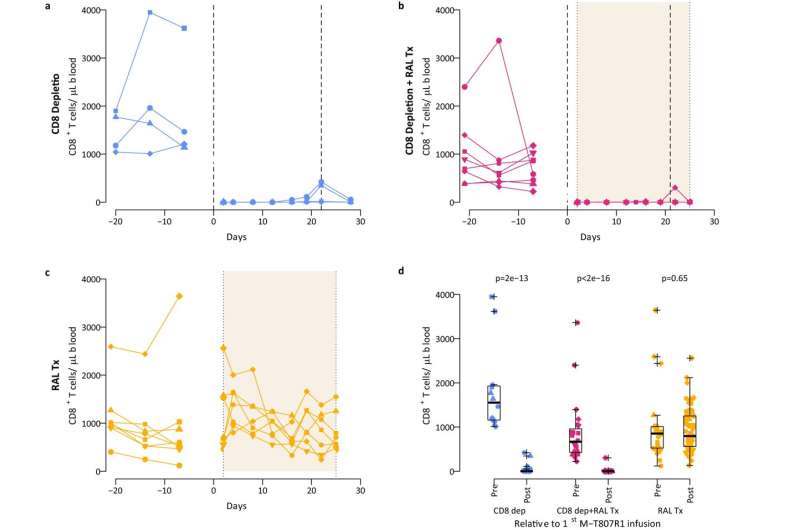This article has been reviewed according to Science X's editorial process and policies. Editors have highlighted the following attributes while ensuring the content's credibility:
fact-checked
peer-reviewed publication
trusted source
proofread
Study refines understanding of T cells' action in HIV immune response

New research combining computer modeling and experiments with macaques shows the body's immune system helps control human immunodeficiency virus (HIV) infections largely by suppressing viral production in already infected cells while also killing viral infected cells, but only within a narrow time window at the start of a cell's infection.
"To eliminate HIV, we have to understand how the immune system attempts to control the infection," said Ruy M. Ribeiro, a theoretical biologist at Los Alamos National Laboratory who led the development of the model underpinning the research. Ribeiro is the corresponding author of the paper about the findings, published in Nature Communications.
The research team included Los Alamos Senior Fellow Alan S. Perelson and a former Los Alamos postdoctoral researcher now at the Fred Hutchinson Cancer Research Center. Their collaborators at the University of Pittsburgh managed the experiments with macaques infected with simian immunodeficiency virus (SIV) to validate the model. SIV infections in monkeys behaves the same way as HIV in humans.
Helping the immune system attack HIV
"The immune system can't eliminate an HIV infection," Ribeiro notes, "but pinpointing the existing mechanism by which it is to some extent controlling HIV is very important for designing treatments to enhance that mechanism. If we can modulate the immune system to help control HIV better, we may be able to cure the disease at some point."
Under the overall leadership of Perelson, Los Alamos has been a global leader in modeling viral infections, including HIV, since the mid-1990s. For the Nature Communications paper, the research team extended a mathematical model published in 2017 by Ribeiro and others at Los Alamos that simulates the interactions and lifecycle of cells that will be infected, already infected cells and the virus.
The new model also simulates the potential effects of the immune response, which include killing the cells, generating proteins that suppress the production of virus or helping mount a defense that prevents the virus entering cells.
Resolving an open question about HIV
Specifically focused on a kind of immune response mediated by CD8+ T cells, the research resolved an open question in HIV research: Do these T cells control HIV by killing HIV cells or by triggering human cells to deploy defenses against the infection?
"There's been controversy about whether this type of T cell controls infection by killing infected cells or by somehow controlling the virus without killing infected cells, so we're trying to distinguish these possibilities and mechanisms," Ribeiro said.
The answer turned out to be "a little of both."
To isolate the role of the T cells, the Los Alamos team ran the model to predict the effects of treating groups of infected macaques variously with antibodies and antiviral drugs.
Some macaques were treated with a drug designed to prevent infection by blocking the virus from integrating into the DNA of the macaques' cells. This drug, called an integrase inhibitor, "revealed the dynamics of the early part of the virus lifecycle that we couldn't easily see with other types of treatment," Ribeiro said. "It's as if we used a microscope."
Other macaques were treated with an antibody that depletes the CD8+ T cells, eliminating their role in fighting the infection. A third cohort of macaques received both treatments.
The Los Alamos team then ran the model to analyze the macaque data to determine the effects of the different immune responses. From the model they inferred the most relevant immune mechanisms that more closely described the observed data.
More information: Benjamin B. Policicchio et al, CD8+ T cells control SIV infection using both cytolytic effects and non-cytolytic suppression of virus production, Nature Communications (2023). DOI: 10.1038/s41467-023-42435-8



















